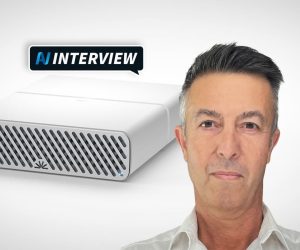
AV Interview: Hans V. Madsen, Cornered Audio
More than a different-shaped enclosure, Cornered Audio is at the pointy end of loudspeaker innovation.
Interview:/ Christopher Holder
Hans V. Madsen doesn’t necessarily claim his epiphany was some kinda divine inspiration, but it did come like a bolt out of the blue. In a half-trance state during a torrid business meeting, he gazed up towards the ceiling and imagined a loudspeaker that fitted neatly in the corner, like an architectural audio cornice.
It wasn’t like Hans was selling greeting cards at the time, he was in the audio business — with Dynaudio and then Martin’s audio division, Mach — but still, he’d imagined something that didn’t really have a precedent. And so began his business, Cornered Audio.
“I’d been in the audio business 20 or so years,” recalls Hans. “It never mattered how good your loudspeaker product sounded, the feedback always was ‘do you have something less visible?’.
Designing a speaker that natively belonged where the walls and ceiling meets would make the loudspeaker as inconspicuous as possible without recessing it.
CORNER THE MARKET
Hans leant on his industry contacts to start prototyping his Cornered concept. What started as a response to a desire for a more aesthetically pleasing loudspeaker turned into an obsession, of sorts. Of course, Hans knew about the bass boost you get from positioning a speaker in a corner but there were other pitfalls and easter eggs along the way. The result is a range of honest-to-goodness commercial loudspeakers that are very pleasing to the ear, and have developed a small legion of rusted-on fans.
But, first, let’s address the boundary interference bass boost question. Hans?
“As everyone knows, if you place a loudspeaker against the wall, for every surface, you get plus 3dB boost in the bass. And this happens roughly from 160Hz and as far down as the room allows. So to avoid a booming bass, we design a roll off in the bass and we can control this by the Q of the box, driver spacing and tuning. That’s all pretty standard. But we also work to adapt some of the woofer’s design principles to tame things in the 100Hz region. In other words, we know how to make a woofer ‘non-hot’ in the 100Hz area, even in a compact cabinet.”
After working with his early Cornered designs and placing them in various real-world environments Hans began to notice something else that surprised and pleased him:


“I can generally recognise one of our speakers when we go into a room — they typically sound quite like they do in any other room. Which was something that took me by surprise in the early days, because even though I had been in the industry for many years; worked with some of the best engineers; and thought I knew about loudspeakers; I was surprised how little the room itself impacted the sound of the Cornered Audio designs — they’re actually pretty ‘room agnostic’. That was difficult for me to get my head around. But then I ran into a Mexican PhD engineer, studying at our technical university in Denmark, who explained the phenomenon to me. He taught me that by having the sound emanating from the corner of the room, the first reflection is indistinguishable from the direct sound. Then the second reflection comes really late. It actually comes optimally late because it travels pretty much as far as you can in the room for the second reflection to bounce back. The result is a very neutral-sounding speaker.
AV: To state the obvious: most surfacemount speakers are mounted up near the corners anyway.
HVM: Right. And when a traditional rectangular loudspeaker is moved all the way to the corners of the room, quite often it’s not tilted towards the centre of the room, it’s just shooting straight out into the room from up against the wall. In that case you get comb filtering from the side wall like you wouldn’t believe — especially at higher frequencies — and this is a problem for speech intelligibility. At lower frequencies it really doesn’t matter much but at high frequencies it’s annoying. When you look at our design, we have it angled into the room at 45°. We actually angle the speaker in the optimal way. If you angled it 50°, then one wall would bounce more than the other. So that’s also why comb filtering in our box is very low.
AV: The response you’re describing sounds more like an omni/point source in free space, which is definitely pleasing to the ear.
HVM: Yeah. And the thing is, the way you perceive a sound in a space is by the reflections you hear — the brain looks at the direct signal compared to the reflected signals and then determines the depth. If you mess with those reflections — either because of a bad crossover design, by bad driver design or resonances in the cabinet — the brain has no information to work with and cannot build a picture of the room, then the sound stage will collapse and you don’t get a room-filling sound.
The room can play the same game. If your reflections from the room are not controlled, then you can’t reproduce the space of the original recording. Some loudspeaker systems intentionally rely on an extra reflection but in my view unwanted or extra reflections are fatiguing to listen to because your brain is constantly trying to interpret the music. Our strategy is to ensure the sound coming from the speaker and the sound created by the room aren’t messing with the original recording. Do that and you feel like you’re being immersed in the sound in the space.
“”
by having the sound emanating from the corner of the room, the first reflection is indistinguishable from the direct sound … The result is a very neutral-sounding speaker

GUARANTEEING PERFORMANCE
AV: You’re a speaker manufacturer and you rely on other people’s amplifiers. How do you guarantee performance?
HVM: It’s basically down to the impedance response of the speaker. So if you look at all our impedance curves, we focus on a high minimum impedance in our passive crossover design — we are never below 6.2 or 6.3Ω. That means any decent amplifier will perform at its best. If your impedance has a couple of the dips, then it places an extra demand on the amplifier. We offer our settings for Blaze and LEA amplifiers and a few others.
AV: Tell me about one of your favourite hospitality installations and why.
HVM: There’s two, actually. One is the Balthazar Bar, which is a champagne bar in Copenhagen at the five-star D’angleterre Hotel. It’s a beautiful bar with lovely cocktails — you instantly become a better human being after an espresso martini at that place. It had a situation with in-ceiling speakers shooting straight down at the end of the wall — you were listening to the ceiling speaker and then all the comb filtering from the walls and it was really horrible. After its launch and after a couple of martinis, it didn’t take long for me to complain about the audio quality. The staff knew it was terrible and the waiters were really fatigued by the audio. I offered to replace the in-ceiling speakers with Cornered Audio speakers. We took out the 12 ceiling speakers and replaced them with only four of our C6TRM units and two subs. This was when we were a very new company, around 13 years ago and our system is still there. DJs now love that bar because of the clean, room-filling sound. Patrons can talk to each other because there’s no compression in the system.
The other installation is opening soon on the Guarda lake in Italy. It’s a ‘restobar’ or supper club — a restaurant for a more mature crowd that morphs into a bar after dinner… expensive cocktails, great architecture, everything is top class. There are 120 or more Cornered Audio loudspeakers in the venue including our 15-inch subs — about 12,000W in total. There will be more of these venues rolled out in the future.

MOUNTING & CABLING
When designing a loudspeaker that could be installed flush in the corner of the ceiling, Hans V. Madsen needed to address what sort of bracket would allow for easy installation and also what to do with the speaker cables, so they wouldn’t get in the way of the installation.
He devised a clever way of placing the speaker wire connectors at the front of the speaker under the grille.
HVM: “I have experts at the exhibitions come to check out my product and tell me the front-mounted cable is ‘stupid’. “That’s really stupid because when you put the grille on, where do you put the cable? It’s the most stupid speaker I’ve ever seen.” After I show them how it works: “Oh, wow. That’s brilliant.” I get a lot of funny reactions. And in terms of installation, the mounting and wiring mean you need to be a bit more organised than a regular surfacemount loudspeaker. But once in position you don’t get spider webs around the cables and you don’t get the cleaning staff dusting the spider webs off, pulling the cable out of the socket and helping to make the bracket tired. Our speakers are always pointing in the right direction, you won’t find one drooped and pointing at the ground. In short, the speaker cable has disappeared from view and the product really cannot be moved.”















RESPONSES